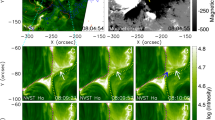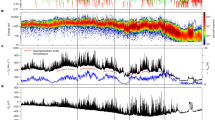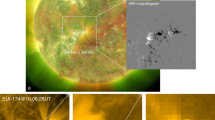Abstract
Magnetic reconnection is a universal process that powers explosive energy-release events such as solar flares, geomagnetic substorms and some astrophysical jets. A characteristic feature of magnetic reconnection is the production of fast reconnection outflow jets near the plasma Alfvén speeds1,2. In eruptive solar flares, dark finger-shaped plasma downflows moving toward the flare arcade have been commonly regarded as the principal observational evidence for such reconnection-driven outflows3,4. However, they often show a speed much slower than that expected in reconnection theories5,6, challenging the reconnection-driven energy-release scenario in standard flare models. Here we present a three-dimensional magnetohydrodynamics model of solar flares. By comparing the model predictions with the observed plasma downflow features, we conclude that these dark downflows are self-organized structures formed in a turbulent interface region below the flare termination shock where the outflows meet the flare arcade, a phenomenon analogous to the formation of similar structures in supernova remnants. This interface region hosts a myriad of turbulent flows, electron currents and shocks, crucial for flare energy release and particle acceleration.
This is a preview of subscription content, access via your institution
Access options
Access Nature and 54 other Nature Portfolio journals
Get Nature+, our best-value online-access subscription
$29.99 / 30 days
cancel any time
Subscribe to this journal
Receive 12 digital issues and online access to articles
$119.00 per year
only $9.92 per issue
Buy this article
- Purchase on Springer Link
- Instant access to full article PDF
Prices may be subject to local taxes which are calculated during checkout




Similar content being viewed by others
Data availability
The SDO/AIA data are publicly available and obtained using the SunPy module Fido.
Code availability
The MHD code is accessible at https://princetonuniversity.github.io/Athena-Cversion/. The AIA data are analysed using the SunPy (https://github.com/sunpy) and AIApy packages (https://pypi.org/project/aiapy). The SolarSoft (SSW) package is obtained from https://www.lmsal.com/solarsoft/ssw. The Chianti atomic data are obtained through https://www.chiantidatabase.org/.
References
Forbes, T. G. & Acton, L. W. Reconnection and field line shrinkage in solar flares. Astrophys. J. 459, 330–341 (1996).
Haggerty, C. C. et al. The reduction of magnetic reconnection outflow jets to sub-Alfvénic speeds. Phys. Plasmas 25, 102120 (2018).
McKenzie, D. E. & Hudson, H. S. X-ray observations of motions and structure above a solar flare arcade. Astrophys. J. 519, L93–L96 (1999).
Savage, S. L., McKenzie, D. E. & Reeves, K. K. Re-interpretation of supra-arcade downflows in solar flares. Astrophys. J. Lett. 747, L40 (2012).
Savage, S. L. & McKenzie, D. E. Quantitative examination of a large sample of supra-arcade downflows in eruptive solar flares. Astrophys. J. 730, 98 (2011).
Innes, D. E., Guo, L. J., Bhattacharjee, A., Huang, Y. M. & Schmit, D. Observations of supra-arcade fans: instabilities at the head of reconnection jets. Astrophys. J. 796, 27 (2014).
Innes, D. E., McKenzie, D. E. & Wang, T. Observations of 1,000 km s−1 Doppler shifts in 107 K solar flare supra-arcade. Sol. Phys. 217, 267–279 (2003).
Lin, J. et al. Direct observations of the magnetic reconnection site of an eruption on 2003 November 18. Astrophys. J. 622, 1251–1264 (2005).
Liu, W., Chen, Q. & Petrosian, V. Plasmoid ejections and loop contractions in an eruptive M7.7 solar flare: evidence of particle acceleration and heating in magnetic reconnection outflows. Astrophys. J. 767, 168 (2013).
Warren, H. P. et al. Spectroscopic observations of current sheet formation and evolution. Astrophys. J. 854, 122 (2018).
Cassak, P. A. et al. On the cause of supra-arcade downflows in solar flares. Astrophys. J. 775, L14 (2013).
Cécere, M., Zurbriggen, E., Costa, A. & Schneiter, M. 3D MHD simulation of flare supra-arcade downflows in a turbulent current sheet medium. Astrophys. J. 807, 6 (2015).
Guo, L. J., Huang, Y. M., Bhattacharjee, A. & Innes, D. E. Rayleigh–Taylor type instabilities in the reconnection exhaust jet as a mechanism for supra-arcade downflows in the Sun. Astrophys. J. 796, L29 (2014).
Reeves, K. K., Freed, M. S., McKenzie, D. E. & Savage, S. L. An exploration of heating mechanisms in a supra-arcade plasma sheet formed after a coronal mass ejection. Astrophys. J. 836, 55 (2017).
Longcope, D., Unverferth, J., Klein, C., McCarthy, M. & Priest, E. Evidence for downflows in the narrow plasma sheet of 2017 September 10 and their significance for flare reconnection. Astrophys. J. 868, 148 (2018).
Masuda, S., Kosugi, T., Hara, H., Tsuneta, S. & Ogawara, Y. A loop-top hard X-ray source in a compact solar flare as evidence for magnetic reconnection. Nature 371, 495–497 (1994).
Krucker, S. et al. Measurements of the coronal acceleration region of a solar flare. Astrophys. J. 714, 1108–1119 (2010).
Chen, B. et al. Measurement of magnetic field and relativistic electrons along a solar flare current sheet. Nat. Astron. 4, 1140–1147 (2020).
Fleishman, G. D. et al. Decay of the coronal magnetic field can release sufficient energy to power a solar flare. Science 367, 278–280 (2020).
Chen, B. et al. Particle acceleration by a solar flare termination shock. Science 350, 1238–1242 (2015).
Takasao, S., Matsumoto, T., Nakamura, N. & Shibata, K. Magnetohydrodynamic shocks in and above post-flare loops: two-dimensional simulation and a simplified model. Astrophys. J. 805, 135 (2015).
Somov, B. V. & Kosugi, T. Collisionless reconnection and high-energy particle acceleration in solar flares. Astrophys. J. 485, 859–868 (1997).
Reeves, K. K. et al. Hot plasma flows and oscillations in the loop-top region during the 2017 September 10 X8.2 solar flare. Astrophys. J. 905, 165 (2020).
Miles, A. R. The blast-wave-driven instability as a vehicle for understanding supernova explosion structure. Astrophys. J. 696, 498–514 (2009).
Warren, J. S. et al. Cosmic-ray acceleration at the forward shock in Tycho’s supernova remnant: evidence from Chandra X-ray observations. Astrophys. J. 634, 376–389 (2005).
Hanneman, W. J. & Reeves, K. K. Thermal structure of current sheets and supra-arcade downflows in the solar corona. Astrophys. J. 786, 95 (2014).
Savage, S. L., McKenzie, D. E., Reeves, K. K., Forbes, T. G. & Longcope, D. W. Reconnection outflows and current sheet observed with Hinode/XRT in the 2008 April 9 ‘Cartwheel CME’ flare. Astrophys. J. 722, 329–342 (2010).
Yu, S. et al. Magnetic reconnection during the post-impulsive phase of a long-duration solar flare: bidirectional outflows as a cause of microwave and X-ray bursts. Astrophys. J. 900, 17 (2020).
Su, Y. et al. Imaging coronal magnetic-field reconnection in a solar flare. Nat. Phys. 9, 489–493 (2013).
Stone, J. M., Gardiner, T. A., Teuben, P., Hawley, J. F. & Simon, J. B. Athena: a new code for astrophysical MHD. Astrophys. J. Supp. 178, 137–177 (2008).
Lemen, J. R. et al. The Atmospheric Imaging Assembly (AIA) on the Solar Dynamics Observatory (SDO). Sol. Phys. 275, 17–40 (2012).
O’Dwyer, B., Del Zanna, G., Mason, H. E., Weber, M. A. & Tripathi, D. SDO/AIA response to coronal hole, quiet Sun, active region, and flare plasma. Astron. Astrophys. 521, A21 (2010).
Shen, C., Lin, J. & Murphy, N. Numerical experiments on fine structure within reconnecting current sheets in solar flares. Astrophys. J. 737, 14 (2011).
Shen, C., Kong, X., Guo, F., Raymond, J. C. & Chen, B. The dynamical behavior of reconnection-driven termination shocks in solar flares: magnetohydrodynamic simulations. Astrophys. J. 869, 116 (2018).
Meyer, C. D., Balsara, D. S. & Aslam, T. D. A second-order accurate Super TimeStepping formulation for anisotropic thermal conduction. Mon. Not. R. Astron. Soc. 422, 2102–2115 (2012).
Klimchuk, J. A., Patsourakos, S. & Cargill, P. J. Highly efficient modeling of dynamic coronal loops. Astrophys. J. 682, 1351–1362 (2008).
Yokoyama, T. & Shibata, K. Magnetohydrodynamic simulation of a solar flare with chromospheric evaporation effect based on the magnetic reconnection model. Astrophys. J. 549, 1160–1174 (2001).
Kopp, R. & Pneuman, G. Magnetic reconnection in the corona and the loop prominence phenomenon. Sol. Phys. 50, 85–98 (1976).
Boerner, P. et al. Initial calibration of the Atmospheric Imaging Assembly (AIA) on the Solar Dynamics Observatory (SDO). Sol. Phys. 275, 41–66 (2012).
Dere, K. P., Del Zanna, G., Young, P. R., Landi, E. & Sutherland, R. S. CHIANTI—an atomic database for emission lines. XV. Version 9, improvements for the X-ray satellite lines. Astrophys. J. Supp. 241, 22 (2019).
Feldman, U. Elemental abundances in the upper solar atmosphere. Phys. Scr. 46, 202–220 (1992).
Priest, E. & Forbes, T. Magnetic Reconnection: MHD Theory and Applications Ch. 4 (Cambridge Univ. Press, 2000).
Petschek, H. E. Magnetic Field Annihilation Vol. 50 (NASA Special Publication,1964).
Forbes, T. G. & Priest, E. R. A comparison of analytical and numerical models for steadily driven magnetic reconnection. Rev. Geophys. 25, 1583–1607 (1987).
Yokoyama, T. & Shibata, K. What is the condition for fast magnetic reconnection? Astrophys. J. Lett. 436, L197–L200 (1994).
Strauss, H. R. Turbulent reconnection. Astrophys. J. 326, 412–417 (1988).
Lazarian, A. et al. Turbulence, magnetic reconnection in turbulent fluids and energetic particle acceleration. Space Sci. Rev. 173, 557–622 (2012).
Lazarian, A. et al. 3D turbulent reconnection: theory, tests, and astrophysical implications. Phys. Plasmas 27, 012305 (2020).
Loureiro, N. F., Schekochihin, A. A. & Cowley, S. C. Instability of current sheets and formation of plasmoid chains. Phys. Plasmas 14, 100703 (2007).
Bhattacharjee, A., Huang, Y.-M., Yang, H. & Rogers, B. Fast reconnection in high-Lundquist-number plasmas due to the plasmoid instability. Phys. Plasmas 16, 112102 (2009).
Ni, L. et al. Linear plasmoid instability of thin current sheets with shear flow. Phys. Plasmas 17, 052109 (2010).
Mei, Z. et al. Numerical experiments on magnetic reconnection in solar flare and coronal mass ejection current sheets. Mon. Not. R. Astron. Soc. 425, 2824–2839 (2012).
Ye, J., Shen, C., Raymond, J. C., Lin, J. & Ziegler, U. Numerical study of the cascading energy conversion of the reconnection current sheet in solar eruptions. Mon. Not. R. Astron. Soc. 482, 588–605 (2019).
Ji, H. & Daughton, W. Phase diagram for magnetic reconnection in heliophysical, astrophysical, and laboratory plasmas. Phys. Plasmas 18, 111207 (2011).
Cassak, P. A., Liu, Y. H. & Shay, M. A. A review of the 0.1 reconnection rate problem. J. Plasma Phys. 83, 715830501 (2017).
Huang, Y.-M. & Bhattacharjee, A. Turbulent magnetohydrodynamic reconnection mediated by the plasmoid instability. Astrophys. J. 818, 20 (2016).
Yang, L. et al. Fast magnetic reconnection with turbulence in high Lundquist number limit. Astrophys. J. Lett. 901, L22 (2020).
Zhou, Y. Rayleigh–Taylor and Richtmyer–Meshkov instability induced flow, turbulence, and mixing. I. Phys. Rep. 720, 1–136 (2017).
Alon, U., Hecht, J., Ofer, D. & Shvarts, D. Power laws and similarity of Rayleigh–Taylor and Richtmyer–Meshkov mixing fronts at all density ratios. Phys. Rev. Lett. 74, 534–537 (1995).
McKenzie, D. E. Turbulent dynamics in solar flare sheet structures measured with local correlation tracking. Astrophys. J. 766, 39 (2013).
Samanta, T. et al. Plasma heating induced by tadpole-like downflows in the flaring solar corona. Innovation 2, 100083 (2021).
Aschenbach, B., Egger, R. & Trümper, J. Discovery of explosion fragments outside the Vela supernova remnant shock-wave boundary. Nature 373, 587–590 (1995).
Balick, B. & Frank, A. Shapes and shaping of planetary nebulae. Annu. Rev. Astron. Astrophys. 40, 439–486 (2002).
Attal, N. & Ramaprabhu, P. Numerical investigation of a single-mode chemically reacting Richtmyer–Meshkov instability. Shock Waves 25, 307–328 (2015).
Chen, F., Xu, A. & Zhang, G. Collaboration and competition between Richtmyer–Meshkov instability and Rayleigh–Taylor instability. Phys. Fluids 30, 102105 (2018).
Wheatley, V., Gehre, R. M., Samtaney, R. & Pullin, D. I. The magnetohydrodynamic Richtmyer–Meshkov instability: the oblique field case. In 29th International Symposium on Shock Waves (eds. Riccardo, B & Devesh, R) Vol. 2 1107-1112 (Springer International Publishing, 2015).
Acknowledgements
The authors thank L. Guo for the help on the modelling setup and J. Raymond, N. Murphy and J. Lin for helpful discussions. The AIA is an instrument on SDO, a National Aeronautics and Space Administration mission. CHIANTI is a collaborative project involving George Mason University (USA), the University of Michigan (USA) and the University of Cambridge (UK). The computations in this paper were conducted on the Smithsonian High Performance Cluster, Smithsonian Institution (https://doi.org/10.25572/SIHPC). C.S. and K.R.R. are supported by National Science Foundation grants AST-1735525, AGS-1723313 and AGS-1723425 to Smithsonian Astrophysical Observatory. B.C. and S.Y. are supported by National Science Foundation grants AGS-1654382, AGS-1723436 and AST-1735405 to New Jersey Institute of Technology. V.P. acknowledges support from National Science Foundation Solar Heliospheric and INterplanetary Environment grant AGS-1723409. X.X. is supported by the Chinese Academy of Sciences grants XDA17040507 and QYZDJ-SSWSLH012, National Natural Science Foundation of China grant 11933009, Yunnan Province grant 2018HC023 and the scholarship granted by the China Scholarship Council under file No. 201904910573.
Author information
Authors and Affiliations
Contributions
C.S. performed the MHD simulations and analysed the results. B.C. and K.R.R. proposed the study and contributed to the modelling setup and results analysis. S.Y., V.P. and X.X. contributed to EUV data collection, analysis and visualization. C.S. and B.C. led the manuscript writing, and all authors discussed the results and commented on the manuscript.
Corresponding author
Ethics declarations
Competing interests
The authors declare no competing interests.
Peer review
Peer review information
Nature Astronomy thanks the anonymous reviewers for their contribution to the peer review of this work.
Additional information
Publisher’s note Springer Nature remains neutral with regard to jurisdictional claims in published maps and institutional affiliations.
Supplementary information
Supplementary Information
Supplementary information.
Supplementary Video 1
Temporal evolution of the magnetic field and density in the centre plane (x = 0) in Case A. The perturbations appear at the density interface and gradually develop to finger-like downflows with low density.
Supplementary Video 2
Evolution of the flare fan and SADs observed by SDO/AIA in its 131 Å EUV filter band on 2015 June 18.
Rights and permissions
About this article
Cite this article
Shen, C., Chen, B., Reeves, K.K. et al. The origin of underdense plasma downflows associated with magnetic reconnection in solar flares. Nat Astron 6, 317–324 (2022). https://doi.org/10.1038/s41550-021-01570-2
Received:
Accepted:
Published:
Issue Date:
DOI: https://doi.org/10.1038/s41550-021-01570-2
This article is cited by
-
Chromospheric Evaporation by Particle Beams in Multi-Dimensional Flare Models
Solar Physics (2023)
-
Numerical MHD Simulations of Reconnection in Solar Flares: Effects of the Magnetic-Field Strength in the Current Sheet
Solar Physics (2023)
-
Velocity and Dissipation Characteristics of Turbulence in Solar-Flare Plasma: An Application of Stochastic Lagrangian Models
Solar Physics (2023)
-
Defining the Middle Corona
Solar Physics (2023)
-
A happy ending for SADs
Nature Astronomy (2022)



